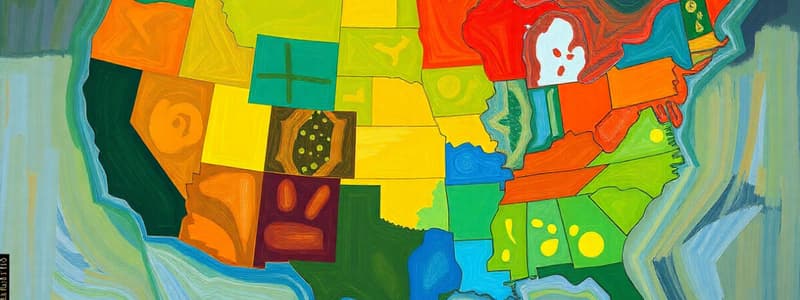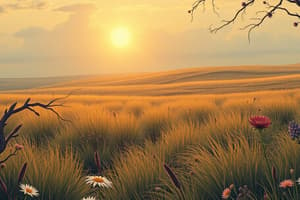Podcast
Questions and Answers
What is the primary distinction between climate and weather?
What is the primary distinction between climate and weather?
- Weather refers to long-term atmospheric conditions.
- Climate refers to atmospheric conditions over a long period of time. (correct)
- Climate denotes specific atmospheric conditions for a short time.
- Weather indicates average temperature and precipitation patterns.
Which of the following climates is characterized by warm temperatures and abundant rainfall?
Which of the following climates is characterized by warm temperatures and abundant rainfall?
- Polar climate
- Tropical climate (correct)
- Temperate climate
- Desert climate
What type of forest is characterized by conifer trees and cold climate zones?
What type of forest is characterized by conifer trees and cold climate zones?
- Tropical dry forest
- Boreal forest (correct)
- Tropical rainforest
- Temperate forest
Which of the following forests experiences seasonal leaf shedding during winter?
Which of the following forests experiences seasonal leaf shedding during winter?
What factor primarily influences climate variation across the Earth?
What factor primarily influences climate variation across the Earth?
Where is the oceanic climate predominantly found in the Americas?
Where is the oceanic climate predominantly found in the Americas?
What unique characteristic do tropical rainforests exhibit compared to regular forests?
What unique characteristic do tropical rainforests exhibit compared to regular forests?
Which type of climate is mainly found in the North American Great Plains and Canada?
Which type of climate is mainly found in the North American Great Plains and Canada?
Which biome is predominantly found in areas closest to the Arctic Circle?
Which biome is predominantly found in areas closest to the Arctic Circle?
What distinguishes a prairie from a forest?
What distinguishes a prairie from a forest?
What climate is found at the poles and is characterized by extremely cold temperatures?
What climate is found at the poles and is characterized by extremely cold temperatures?
Which biome is most likely to thrive in tropical climate zones?
Which biome is most likely to thrive in tropical climate zones?
Which statement correctly describes steppes compared to deserts?
Which statement correctly describes steppes compared to deserts?
What is a significant characteristic of the desert climate found in the Americas?
What is a significant characteristic of the desert climate found in the Americas?
What type of vegetation is primarily found in tropical dry forests?
What type of vegetation is primarily found in tropical dry forests?
Which animals are typically associated with the tundra biome?
Which animals are typically associated with the tundra biome?
Which river is primarily associated with the Arctic drainage basin in North America?
Which river is primarily associated with the Arctic drainage basin in North America?
What are the names of the Great Lakes in North America?
What are the names of the Great Lakes in North America?
Which drainage basin is associated with the long, fast-flowing rivers of the Atlantic Seaboard?
Which drainage basin is associated with the long, fast-flowing rivers of the Atlantic Seaboard?
Which two rivers are primarily found in the Pacific drainage basin in North America?
Which two rivers are primarily found in the Pacific drainage basin in North America?
What defines a gulf compared to a bay?
What defines a gulf compared to a bay?
Which of these is NOT one of the most important lakes in Central America?
Which of these is NOT one of the most important lakes in Central America?
Which lake is shared by Peru and Bolivia?
Which lake is shared by Peru and Bolivia?
What is the main feature of San Juan Bay and Guánica Bay in Puerto Rico?
What is the main feature of San Juan Bay and Guánica Bay in Puerto Rico?
Flashcards are hidden until you start studying
Study Notes
Climate Overview
- America features diverse climates, influencing a wide range of landscapes and habitats.
- Distinction exists between climate (long-term atmospheric conditions) and weather (short-term conditions).
- Sun’s angle and Earth's curvature cause temperature variations; the Equator is warmer than the poles.
- Altitude impacts climate; higher elevations typically experience cooler temperatures.
Types of Climate in America
- Cold climates located in mountains and continental edges; includes polar climate around the Arctic Circle.
- High mountain climates found in Andean valleys and peaks.
- Tropical climates prevalent near the Equator; characterized by warmth and heavy rainfall.
- Desert climates in regions like the Nevada Desert and Atacama Desert experience low precipitation.
- Temperate climates spread across North and South America; includes continental climates with cold winters.
Biomes of America
- Biomes consist of ecosystems sharing similar geography, climate, and species.
- Boreal forests (taiga) thrive in cold regions; dominated by coniferous trees like pines.
- Temperate forests feature deciduous trees, common in the northwestern U.S., changing colors in fall.
- Tropical rainforests are dense with greenery and biodiversity; the Amazon is the largest in America.
- Tundra is characterized by low vegetation; found near the Arctic and in the Andes.
Grasslands and Deserts
- Prairies are flatter regions with grasses, less rain, and sparse fauna found across several countries.
- Savannahs are warmer and drier, hosting grassy areas with minimal trees; common in Central and South America.
- Steppes are grasslands with higher rainfall than deserts; found in central U.S., northern Mexico, and Argentina.
- Deserts, such as those in the U.S. and Peru, exemplify extreme temperature shifts between day and night.
Water Bodies in America
- Rivers and lakes are crucial for water supply and have historically shaped societal development.
- Three main drainage basins: Arctic (includes Mackenzie River), Atlantic Seaboard (features the Mississippi), and Pacific (includes Yukon and Colorado).
- Great Lakes (Superior, Michigan, Huron, Erie, Ontario) are significant freshwater bodies in North America.
- Central America has important lakes like Nicaragua and Managua; South America features Lake Maracaibo and Lake Titicaca, one of the highest lakes globally.
Gulfs and Bays
- Gulfs are large sea areas enclosed by coastlines; notable examples include the Gulf of Mexico and Gulf of California.
- Bays are coastal inlets, surrounded by land on three sides; includes San Juan Bay and Hudson Bay in North America.
Studying That Suits You
Use AI to generate personalized quizzes and flashcards to suit your learning preferences.




